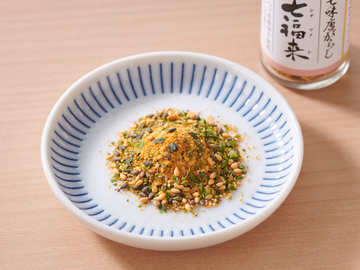Soy sauce, miso, other seasonings

History and Culture
Seasonings are essential for cooking. Seasonings create sweetness, saltiness, bitterness, sourness, and umami, the five taste elements, and bring out the flavors of foodstuffs. One of the attractive aspects of seasonings is their vast variety between countries and regions, together with the long history they have taken root locally.
Common seasonings in Japanese diets include miso, soy sauce, vinegar, and mirin, which are fermented seasonings made from grains. These seasonings are mixed with condiments such as wasabi, mustard, ginger, and Japanese pepper, and people appreciate the unique flavors and sense of seasons, based on which Japanese food culture has been developed.
There are various fermented foods in Japan, and salt is an indispensable seasoning for fermented foods. Around the 7th century, people established a method to harvest a large amount of salt by making a vast salt field on a sandy beach. Aside from the aspect of salt as a seasoning, the advent of salt became a momentum to produce miso, soy sauce, and other fermented foods by making use of the properties of salt as a preservative that protects foodstuffs from becoming spoiled.
In addition, the rich blessings of nature also created the concept of Japanese culinary methods using seasonings in combination with condiment spices such as wasabi, mustard, ginger, and Japanese pepper. These spices have antimicrobial/microbicidal effects and in Japan, people developed a unique food culture of eating sashimi and other raw foods by making use of the functionality of nature.
Characteristics and Types
The characteristics of typical seasonings are presented in the following sections.
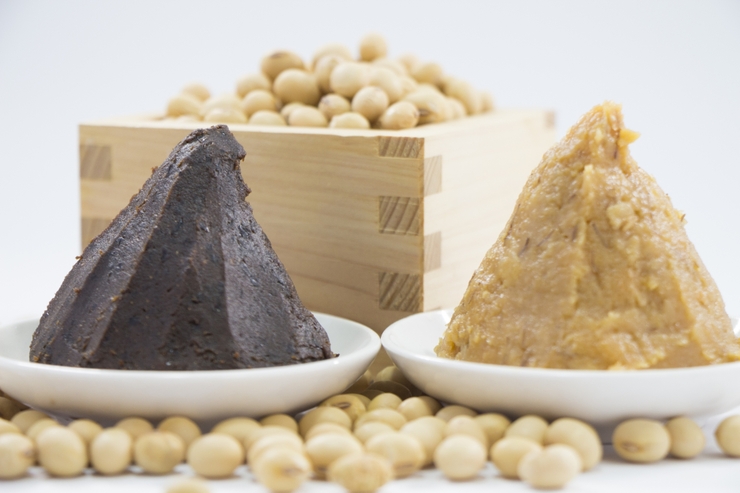
[Miso]
Miso is a salty fermented seasoning representative of Japanese cuisine, and there is a theory that miso was introduced to Japan in 666 A.D. from Goguryeo. There are descriptions of "misho" (末醤) and "miso" (末蘇) in "Shoso-in documents," and "misho" (未醤) in "Wamyoruijisho." In medieval Japan, as the production volume of soybeans increased, production of miso was no longer limited within temples, and people started making homemade miso in villages.
Miso is made by mixing koji and salt in steamed soybeans. Koji is made from rice, barley, or soybeans as a raw material, and miso is classified into three categories based on koji type: rice miso made from rice koji, barley miso made from barley koji, and soybean miso made from soybean koji. Rice miso can further be classified into three types according to salt content: ama-miso (sweet miso; white and red), amakuchi-miso (mildly salty miso; light-colored and red), and karakuchi-miso (salty miso; light-colored and red), while barley miso has two types, light-colored miso and red miso. The color of miso is affected by the length of aging.
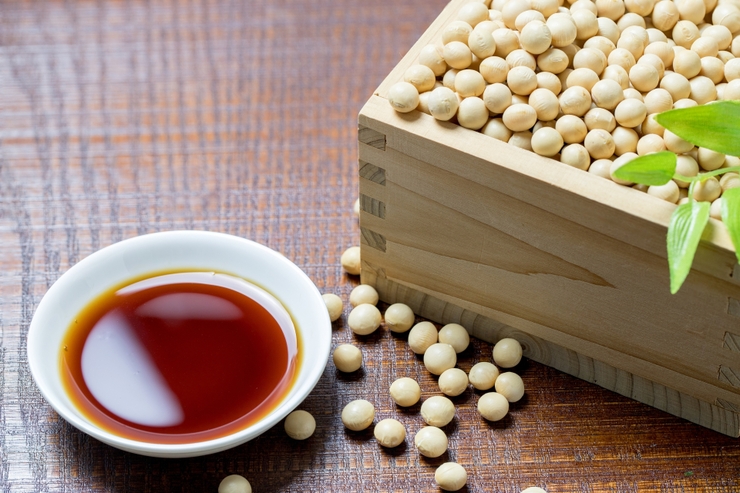
[Soy sauce]
Soy sauce is a fermented seasoning essential for Japanese cuisine. The original form of soy sauce is considered to be hishio ("醤 (比之保)," foodstuffs fermented with salt, e.g., kokubishio and shishibishio) introduced from China. Its history dates back to the time of "Taiho Code" (701 A.D.), which has a record of production of hishio from soybeans. In the Kamakura period, a Japanese Zen priest named Kakushin from Shinshu brought kinzanji (Jingshansi) miso back from China into Japan, and this became the original form of tamari soy sauce. Tamari soy sauce was known to have been developed into the modern type of soy sauce we use today by the end of the Muromachi period. The word shoyu or soy sauce, appeared in the literature "Ekirinbon-setsuyoshu" (1597) for the first time.
Soy sauce can be classified into five categories according to the flavor and color, which are determined based on ingredients, salt content, length of aging, and other conditions: koikuchi (dark-colored) soy sauce, usukuchi (light-colored) soy sauce, tamari (thick) soy sauce, saishikomi soy sauce (soy sauce brewed in another fresh soy sauce), and shiro (white) soy sauce.
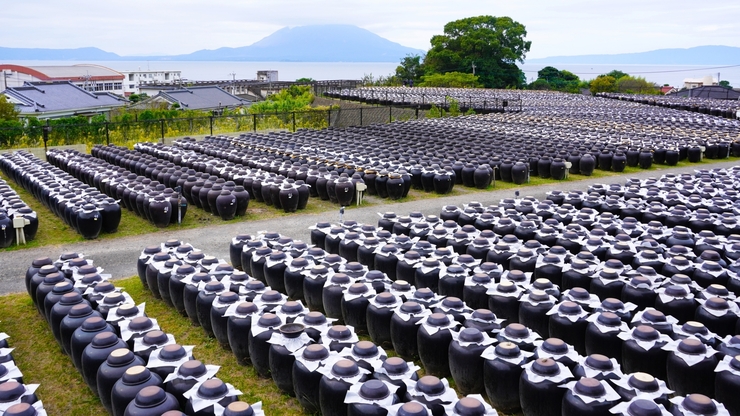
[Vinegar]
Vinegars are the oldest known seasonings in human history. During storage, harvested grains and fruits turned to alcoholic beverages as they underwent fermentation, and then the taste turned sour when the liquid was left to stand some time. Humans started using the liquid as vinegar. In Japan, the history dates back to old times, and it is considered to be introduced to Japan around the time of Emperor Ojin. The "Taiho Code" (701 A.D.) stated that persons (mikinotsukasa) in charge of making sake, amazake, vinegar, and other products held government posts. In the late Edo period, after the method of producing kasu vinegar (粕酢) from sake lees was invented, kasu vinegar became widespread with the growing popularity of Edo-style sushi, because kasu vinegar was less expensive than rice vinegar and its flavor went well with sushi.
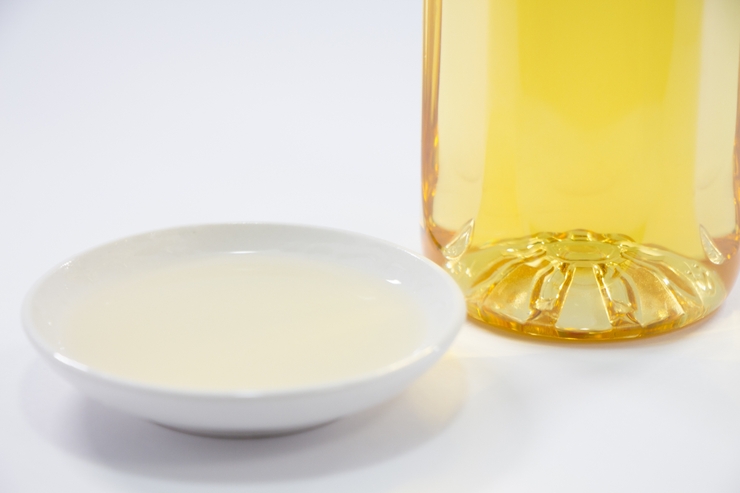
[Mirin]
Like vinegar, mirin is produced by applying the brewing method of sake. Its production is characterized by the use of steamed glutinous rice for rice koji, and spirits such as shochu as raw materials. There are theories that explain the origin of mirin: one theory suggests that nerizake, sweet sake consumed in the early Muromachi period, was the origin of mirin, and the other theory suggests that mirin (蜜淋), which was mead consumed in China in the Ming Dynasty, was the origin. In the Edo period, when the technology for the production of high sugar-content mirin made from shochu was established, people gradually started using mirin also as a seasoning.
Mirin is an indispensable seasoning for Japanese cuisine not only for adding sweetness to food, but also for utilizing a variety of cooking effects, which include enhancement of permeation of the seasoning components into foodstuffs, giving a glossy or shiny look to dishes, preventing cooked foodstuffs from falling apart, and removing fishy smells.
[Other seasonings]
In addition to salt and sugar, spices such as wasabi, Japanese pepper, mustard, pepper, and chili pepper also have a long history as Japanese seasonings. These seasonings can be used not only to enjoy the effects of spiciness and flavors, but also to prevent foodstuffs from being spoiled, and remove fishy smells. Main seasonings are presented below.
[Sugar]
Sugar is a sweetener mainly composed of sucrose, and made from sugarcane produced in Okinawa, Kagoshima, and other areas or sugar beets produced in Hokkaido. Sugar was introduced to Japan during the time when Japanese envoys were sent to Tang Dynasty China, and was recognized for some time as an expensive product used for medical purposes. Subsequently, sugar gradually came to be used for sweets with the growing popularity of the tea ceremony. However, sugar was not used for cooking until modern times. Sugar is also commonly used as a secondary ingredient to enhance food preservation. Sugar is used for this purpose in a variety of products including candied fruit, jams, breads, and sweets.
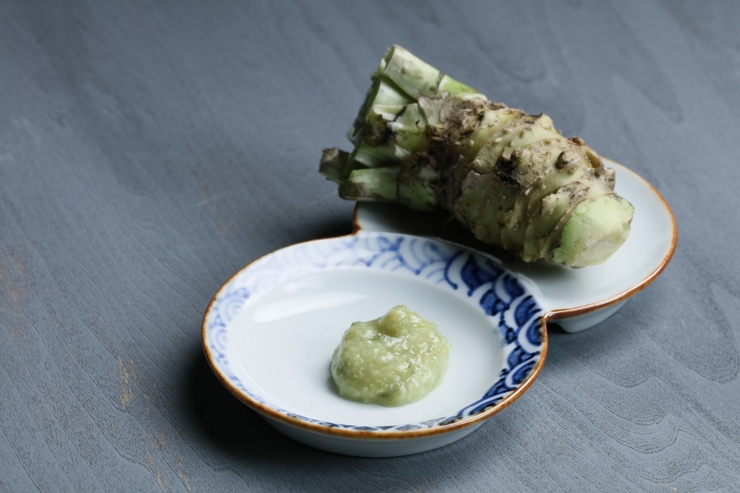
[Wasabi]
Wasabi is a cruciferous vegetable and is native to Japan. Wasabi has a fresh pungency that travels through the nose, and is indispensable for sashimi among other dishes. Wasabi has a microbicidal effect and it also goes well with dishes eaten raw. There are documents that indicate wasabi had already been used as a spice in the Heian period. In the Edo period, wasabi was used in combination with nigiri-zushi, sashimi, or soba noodles, and became widespread among ordinary people.
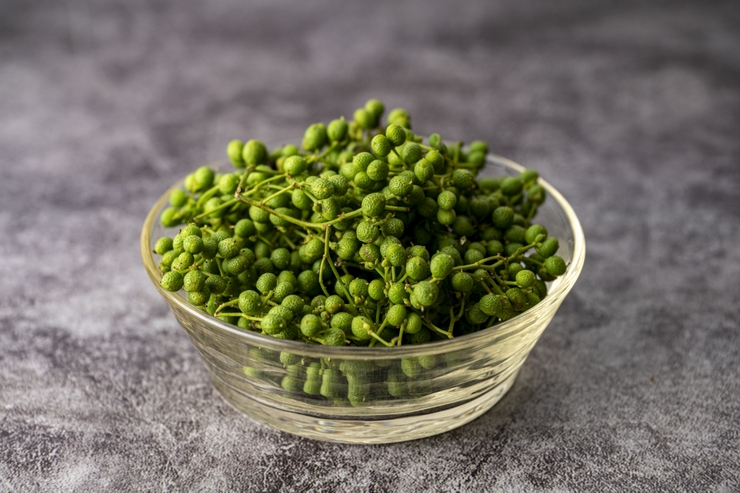
[Japanese pepper]
Japanese pepper has a citrus aroma with characteristic tongue-tingling hotness and pungent flavor. Powdered Japanese pepper is the commonly available form, which was made by powdering the dried peel of the fruit. A sprinkle of Japanese pepper adds freshness to rich flavor dishes such as broiled eels and teriyaki. New leaves are used as a condiment.
Production Methods
[Miso]
Mix rice-koji and salt in steamed soybeans. Pack the mixture in a manner that prevents air from entering. While salt suppresses the growth of undesirable bacteria, starch in rice is decomposed into sugar by the amylolytic enzymes from Aspergillus oryzae. Soybean protein is decomposed by proteolytic enzymes from Aspergillus oryzae into amino acids, which gives rich umami to miso. Next, lactic acid bacteria produce lactic acid using sugar, and yeast grows while producing ethanol. The length of aging varies greatly, ranging from several days to two years, which gives different flavor and taste.
[Soy sauce]
Soybean, rice, barley, and other grains are used as raw materials. Koji and salt water are added to the steamed grains, and the mixture is fermented and aged. After the umami component is produced by Aspergillus oryzae, lactic acid bacteria and yeast produce distinct aroma of soy sauce. Soy sauce is a seasoning created by a fermentation method backed by delicate technique unique to Japan.
[Vinegar]
Refined sake is made from rice. Then the "mother of vinegar" (film of acetic acid bacteria) is allowed to form on the sake so that acetic acid fermentation takes place. Grain vinegar made using sake lees, a byproduct from the refined sake production process, is called kasu vinegar. Kasu vinegar is produced by aging sake lees for a certain period of time, adding water, and inoculating the "mother of vinegar" to allow static fermentation to occur.
[Mirin]
Steamed rice is added to shochu with rice koji. After saccharification and aging at 20°C to 30°C for 40 to 60 days, the mixture undergoes compression, orisage (sedimentation), and filtration, which is followed by storage for several months to complete brewing.
Relationship with Regions
Various types of miso and soy sauce are produced according to the types of raw materials and koji, aging period, and local taste preference. Regional characteristics of miso and soy sauce are presented below.
[Miso]
Miso is classified into rice miso, barley miso, soybean miso, and blended miso, and all these types of miso fall in the category of "ordinary miso." Rice miso can further be classified into three types according to the amount of koji and salt used: ama-miso, amakuchi-miso, and karakuchi-miso.
White ama-miso is clear light yellowish-white in color, and is characterized by a distinctive flavor that comes from rice koji. Saikyo miso made in Kyoto, Sanuki miso made in Kagawa Prefecture, and Fuchu miso made in Hiroshima Prefecture are well-known miso of this type.
Red ama-miso is brownish-red, glossy miso represented by Edo-style ama-miso, and has a unique flavor produced by the combination of the savory aromas of koji and soybeans.
Aijiro miso made in Shizuoka Prefecture and Gozen miso made in Tokushima Prefecture are well-known amakuchi-miso. Amakuchi-miso is also produced in the Setouchi region.
Karakuchi-miso is made over a long brewing period. Among the types of rice miso, karakuchi-miso is produced in the largest amounts. Shinshu miso and Sendai miso are representative miso of this type.
Barley miso is also called "inaka (country-style) miso," and the production areas are limited to Kyushu, Shikoku, and Chugoku regions and some parts of the Kanto region.
Soybean miso does not use rice or barley in the production, and instead, all ingredient soybeans are turned into koji. It is dark brownish-red, and has a distinctive aroma, with a robust and rich umami and a slightly astringent taste. Soybean miso is produced only in Aichi Prefecture, Gifu Prefecture, and Mie Prefecture. Soybean miso produced in the regions may be called "Hatcho miso," "Nagoya miso," "Sanshu miso," or "Tamari miso."
Classification of miso and major areas of production are shown below.
| Type of miso |
Classification by taste/color |
Koji-to-soybean ratio |
Salt content |
Main production area |
|
|---|---|---|---|---|---|
| Rice miso | Ama-miso | White | 15~30 | 5~7 | Kinki region, Chugoku region, Setouchi region |
| Red | 12~20 | 5~7 | Tokyo | ||
| Amakuchi-miso | Light colored | 8~15 | 7~12 | Shizuoka, Kyushu region | |
| Red | 10~15 | 11~13 | Tokushima, other | ||
| Karakuchi-miso | Light colored | 5~10 | 11~13 | Kanto/Koshinetsu region, Hokuriku region, and other areas across Japan | |
| Red | 5~10 | 11~13 | Kanto/Koshinetsu region, Tohoku region, and other areas across Japan | ||
| Barley miso | Amakuchi-miso | 15~25 | 9~11 | Kyushu region, Chugoku region (along the Sea of Japan coast) | |
| Karakuchi-miso | 8~15 | 11~13 | Kyushu region, Shikoku region, Kanto region (norther part) | ||
| Soybean miso | All made into koji | 10~12 | Chukyo region (Aichi, Mie, Gifu) | ||
"Nihon no Dento Shokuhin Jiten" [Encyclopedia of Traditional Japanese Food] Asakura Publishing Co., Ltd., p.249
[Soy sauce]
Soy sauce commercially available in Japan today can be roughly classified into five categories: koikuchi soy sauce, usukuchi soy sauce, tamari soy sauce, saishikomi soy sauce, and shiro soy sauce.
Of the soy sauce products manufactured across Japan, koikuchi soy sauce accounts for at least 80%. Koikuchi soy sauce, which is widely used in eastern Japan, has rich aroma and can effectively remove undesired fishy or gamey smells of fish and meat.
Usukuchi soy sauce is light-colored soy sauce developed mainly in Kansai region, where it has been used heavily in Kamigata-style cooking, which has strong emphasis on bringing out the best of ingredients without modifying their natural flavor or color. Special techniques are used during the manufacturing process to prevent darkening of soy sauce.
Tamari soy sauce is used only in Tokai region. With rich and distinctive flavor, tamari soy sauce is often used as sauce for sashimi and kabayaki, and also used to flavor rice snacks, tsukudani (foods simmered in sweetened soy sauce), and noodle soup.
Saishikomi soy sauce is produced in Yamaguchi Prefecture and some parts of Kyushu region, and the production volume is small. While Saishikomi soy sauce has slightly lower salt content, it has rich taste and color, with high viscosity. It is used in sushi, in sauce over grilled eel, and dipping sauce for sashimi.
White soy sauce is characterized by its light color, lighter than usukuchi soy sauce, and is produced mainly in Aichi Prefecture. While it has relatively less umami and is light-bodied, the flavor of koji and sweetness stand out.
The table below shows the characteristics of manufacturing methods for each type of soy sauce.
| Type | Manufacturing method/characteristics | Region |
|---|---|---|
| Koikuchi soy sauce | Soy sauce koji is prepared using equal amounts of soybeans and wheat, and the mixture is soaked in salt water to allow fermentation to occur. The duration of fermentation and aging is approximately 8 months. | All regions of Japan |
| Usukuchi soy sauce | Soybeans and wheat are used as raw materials of soy sauce koji, and amazake is added to make the flavor milder. In the production process, various techniques are used to prevent the soy sauce color from becoming dark, such as roasting wheat lightly, and increasing salt content to slow down fermentation/aging. | Kansai region |
| Tamari soy sauce | Soybeans and a small amount of wheat are used as raw materials. Soybeans are crushed and made into miso-koji balls, which are allowed to undergo fermentation with a small amount of salt water. Tamari soy sauce has a longer aging period than koikuchi soy sauce. | Tokai region (Aichi, Gifu, and Mie Prefectures) |
| Saishikomi soy sauce |
Soy sauce koji is prepared using equal amounts of soybeans and wheat, and kiage soy sauce is added instead of salt water for brewing. Saishikomi soy sauce has a long aging period (1.5 to 2 years or longer). | Yamaguchi Prefecture, Sanin through Kyushu region |
| White soy sauce | Soy sauce koji is prepared by using wheat and soy beans at a ratio of 9:1, and brewed with salt water. The duration of fermentation and aging is approximately 3 months. White soy sauce may be produced without processes leading to coloring, or it may undergo the processes only briefly. | Aichi Prefecture |
Contribution to Sustainability and SDGs
Since 2013, when the United Nations Educational, Scientific, and Cultural Organization (UNESCO) agreed to register "Washoku, traditional dietary cultures of the Japanese" as an intangible cultural heritage, a growing number of people overseas became interested in Japanese food culture. In particular, fermented seasonings such as soy sauce and miso, which form the basis of Japanese cuisine, are attracting much attention. Miso and vinegar are highly valued not only for their unique umami formed by fermentation, but also for their abundant health functionality, which are appealing points to stay healthy. (3. Good Health and Well-being)
Reference
Yukimichi Koizumi, Toshio Hashimoto, Yasushi Yamamoto, Hideo Tanaka, Hiroshi Tachi, Toshio Nagashima, and Shiro Yoshimoto, edited by the Japanese Society of Traditional Food, "Nihon no Dento Shokuhin Jiten" [Encyclopedia of Traditional Japanese Food], Asakura Publishing Co., Ltd., p.241-282
The Asahi Shimbun Company, NHK, NHK Promotions Inc. "Official Guidebook: Special exhibition Washoku: Nature and culture in Japanese cuisine: more delicious with more knowledge"
NHK Text "Shumidoki: Kyokara Hakko-Life" [Fermented Foods for Life from Today], April-May 2016
Edited by Otsuka Folklore Society of Japan "Nihon Minzoku Jiten" [Japanese Folklore Encyclopedia], Kobundou Publishers Inc., p.367
Edited by Shigemitsu Kimura et al. "Nihon Seikatsushi Jiten" [Japanese Life History Encyclopedia], Yoshikawa Kobunkan, 2016, p.623-624

